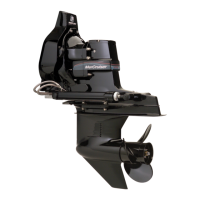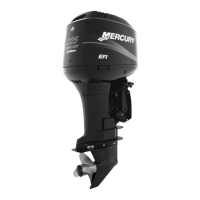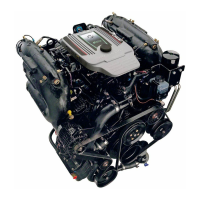TDI Operation Chart
Starting Procedure After Starting While Underway Stopping and Shutdown
Open the engine hatch. Air
out the bilge completely.
Observe all gauges and
indicator lamps to check the
condition of the engine. If not
normal, stop the engine.
Frequently observe all gauges
and indicator lamps to monitor
engine condition.
Shift the remote control lever
to the neutral position.
Turn the battery switch on, if
equipped.
Check for fuel, oil, water, fluid,
and exhaust leaks, etc.
Listen for the audio alarm.
Run the engine at idle‑RPM
for several minutes to allow
the turbocharger and engine
to cool.
Turn on and run the engine
compartment bilge blower, if
equipped, for five minutes.
Check the shift and throttle
control operation.
Turn the key switch to the off
position.
Check for leaks: fuel, oil,
water, fluid, etc.
Check the steering operation.
Turn the battery switch off, if
equipped.
Open the fuel shut‑off valve,
if equipped.
Close the fuel shut‑off valve, if
equipped.
Open the seacock, if
equipped.
Close the seacock, if
equipped.
Prime the fuel injection
system, if necessary.
Flush the seawater cooling
circuit, if operating in
saltwater, brackish water, or
polluted water.
Turn the key switch to the
run position and check that
the lights and indicator
lamps come on.
Turn the key switch to the
start position. Release the
key when the engine starts.
Check that the charge
indicator and oil pressure
indicator lamps are off after
engine starts.
Verify there are no faults.
Warm‑up the engine at a
fast idle‑RPM for several
minutes.
Drain Plug and Bilge Pump
The engine compartment in your boat is a natural place for water to collect. For this reason, boats are normally equipped with a
drain plug or a bilge pump. It is very important to check these items on a regular basis to ensure that the water level does not
come into contact with your power package. Components on your engine will be damaged if submerged. Damage caused by
submersion is not covered by the warranty.
Starting, Shifting, and Stopping
!
WARNING
Vapors can ignite and cause an explosion, resulting in engine damage or severe personal injury. Do not use volatile starting
aids such as ether, propane, or gasoline in the engine air intake system.
!
WARNING
Fuel vapors trapped in the engine compartment may be an irritant, cause difficulty breathing, or may ignite resulting in a fire
or explosion. Always ventilate the engine compartment before servicing the power package.
Section 2 - On The Water
Page 24 90-8M0145546 eng MAY 2018
